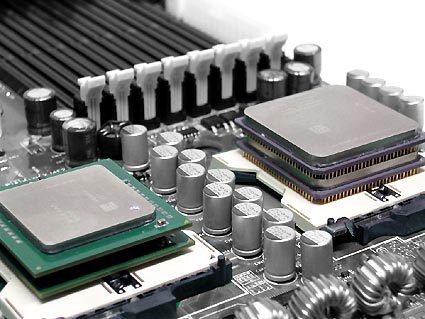AMD's Opteron 250 vs. Intel's Xeon 3.6 GHz in a Workstation Duel of the Elite
AMD Is Winning
For a long time, the workstation sector was stagnating. Now, Intel's Xeon, code-named Nocona, has finally found its way into the retail channels four months after its unveiling. While the device offers a 3.6 GHz clock speed and a technically sophisticated platform, numerous difficulties held back its commercial launch, including an unusual number of steppings that crept into the chipsets.
But all's well that ends well: the Xeon, based on a 90-nm process, and its workstation chipset the E7525/Tumwater, is expected to offer superior performance compared to competing workstation processors. Of course, when we say "competing products," we mean the Opteron, which AMD has had available with speeds up to 2.4 GHz in the form of the Opteron 250 since the beginning of the summer.
With out a doubt, Intel pulled out all the stops to upgrade the new platform. As a result, significant ingredients have been added, which are already spiking the desktop platform based on socket 775, such as PCI Express graphics and DDR2 memory. However, the latter only works with 200 MHz (DDR2-400); DDR333 can be used as an option. A new PCI-X hub called 6700PXH now provides new bus segments for up to 133 MHz - until now the discriminating customer had to rely on chipsets from the competition.
Now the Xeon processors, based on the Nocona core, work with 200 MHz system speed (FSB800), offer a 1 MB L2 cache and handle SSE3. One of these days, the CPUs are also supposed to learn how to handle IEST (Intel Enhanced Speedstep Technology), which should lower the speed dynamically to 2.8 GHz under minimal loads and thus reduce heat loss.
To note, there is the issued of enhanced memory 64 technology, or EM64T for short, which Intel, after a quiet mention at IDF in the spring, is now very inconspicuously postponing. That sounds suspiciously like what the company has had to do with the Pentium 4 Prescott, which in fact is what the processor is. We are assuming that both processors start with the same manufacturing process, but follow different validation routes and finally get a different package.
The Opteron, on the other hand, still works with AMD's reference chipset, the 81xx, which consists of a total of three chips for AGP, PCI-X and I/O. PCI Express does not recognize this chipset, and the nForce4 chipset will soon need to take that into account.
In the case of AMD too there is a close link to its desktop processor line. The Athlon64 FX and the 200-series Opterons, for example, are the same, except for the RAM used (the latter needs registered DRAMs). The DDR400 memory controller is integrated into the processor, affording greater independence from the chipset; all it needs to worry about is I/O and graphics. The recipe is spicy, so it's not surprising that the Opteron really lets it rip when every processor can access its own RAM.
Get Tom's Hardware's best news and in-depth reviews, straight to your inbox.
The status quo is now such that the differences between the Intel and the AMD platforms could not be greater, which at the same time means that the test of strength between the two processor fighting-giants is just that much more interesting.

Patrick Schmid was the editor-in-chief for Tom's Hardware from 2005 to 2006. He wrote numerous articles on a wide range of hardware topics, including storage, CPUs, and system builds.
-
bgd73 hey thanks for this. There is errors in the test, especially in memory speed of xeons, in fact, it is ridiculous. I am going for older 7525 chipset in CEB motherboard...these machines are just getting started. I be sure to go for HT. thanks.Reply
